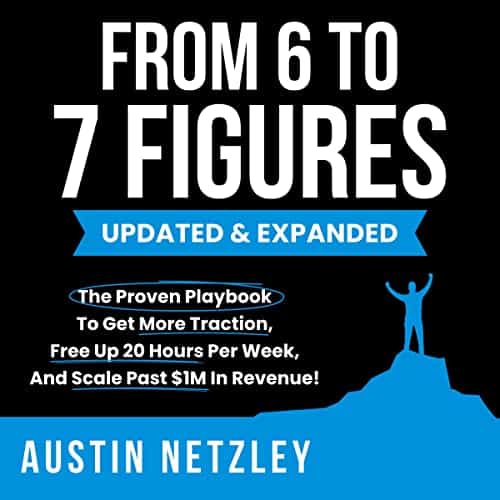From 6 To 7 Figures By Austin Netzley | Book Summary
In his book, From 6 to 7 Figures, Austin Netzley provides his playbook to take six-figure businesses to the million-dollar mark. In his own story, he struggled to reach this milestone and eventually had an epiphany: “What gets you to six figures in revenue is NOT what will get you to multiple millions.”
Buy From 6 To 7 Figures on Amazon

From 6 To 7 Figures By Austin Netzley
Simplify Your Business, Gain Your Time Back, And Scale Faster Than Ever
Introduction
The Path To 7 Figures
“What got you to six figures—the thinking, key actions, strategies, and habits—will not be what gets you to seven figures. … There is a formula for business success. And there is a very important order to things to get the most traction possible.”
There are seven steps that build on one another to help you get consistent, predictable growth and be on the path to seven figures. In the process, you will take control of your time and transform your business from controlling you to you having complete control.
The Numbers To $1+ Million
In The E-Myth Revisited (book summary), Michael Gerber states that 80% of businesses fail in the first five years, of which 80% will fail in the next five years. For those that survive, 40% are profitable, 30% break even, and 30% continually lose money. Worst, only 4% of businesses get to seven figures.
Austin Netzley’s company, 2X, is on a mission to change that statistic with the proven playbook shared in this book. Also, many six-figure entrepreneurs are a few simple (but vital) tweaks away from reaching seven figures per year. The keys to success are consistency and control.
The Free 7-Figure Toolkit
To achieve significant success, it’s not about ideas or information. It’s about implementation and execution. So check out the complete toolkit of resources, including templates, spreadsheets, worksheets, videos, and more.
Download The PDF Book Summary For From 6 to 7 Figures By Austin Netzley
Chapter 1: The Million-Dollar Mindset & Vision
In Chapter 1 of From 6 to 7 Figures, Austin Netzley introduces the 2X Formula, which has nine elements: Mindset, Vision, Strategy, Execution, Numbers, Systems, Team, Sales, and Marketing. The key element is Mindset, which you need to have to scale your business to the next level.
The Hardest Part
The potentially hardest part about business is determining your vision. A compelling personal and business vision helps you drive your strategy, decision-making, execution, and team. Therefore, you should create a three to ten-page overview for the next three years. For more help crafting a vision, check out Cameron Herold’s Vivid Vision process.
WHO You Have to Become
Next, ask yourself, “Who do I have to become to make my vision a reality?” In Atomic Habits (book summary), James Clear discusses how our identity significantly shapes our habits and behaviors. Thus, list the traits, qualities, habits, and mindset shifts necessary for your new identity. For more on habits, check out the book, The Power of Habit (book summary), by Charles Duhigg.
CEO Problem-Solving Mentality
With any new project or issue, think about how it aligns with your future vision and whether it is essential. Then, if it is aligned, ask yourself, “Who should own this project or issue?” and “What systems are needed?”
CEO Survival 101
To achieve your big, audacious goals, you must learn to let go. Therefore, to survive and thrive, you should remove the non-essential to not be stuck working “in” your business. Instead, focus on the highest-leverage actions to consistently work “on” your business.
Chapter 2: Your 7-Figure Strategy
In Chapter 2 of From 6 to 7 Figures, Austin Netzley shows you how to create the right seven-figure strategy that helps you accomplish your vision as soon as possible. 2X defines strategy as your business model, product-market fit, or plan of action.
Market Domination with Model ONE
The strategy to achieve product-market fit is the Model ONE Framework, which asks this question: “Are you selling to the right people, the right products, at the right price, with the right positioning, in a way that can scale?”
- The Right People: Define your Ideal Target Audience (ITA) as your perfect customer for which you can best serve and be the market leader.
- The Right Products: Craft your strategic product slate by creating an Irresistible Offer that appeals to your ITA for what you are best-in-class and your core product or service.
- The Right Price: Set prices strategically for your ITA by examining the cost of expenses, provided value, competitor pricing, and saleability to them.
- The Right Positioning: Use the Blue Ocean Strategy to differentiate yourself as the market leader, make your competition irrelevant, and capture your ITA in blue oceans.
- In A Way That Can Scale: Ensure your business is built to run and scale without you or any other key person or resource.
Your Growth Lever (To Millions)
The best way to grow your business is to create raving fans and maximize customer lifetime value (LTV). You should improve LTV using these four key drivers:
- Price: Raise your prices or go higher-end.
- Products: Provide your customers with newer offers by cross-selling or upselling.
- Retention: Keep your customers longer by providing them with recurring offers.
- Model: Change your business model, payment structures, and/or offerings.
Three Buckets of Great Strategy
Change your strategy from the short-term reactive focus (next 30 days) to more of the medium-term (6-12 months out) and long-term focus (3-5 years out). First, get alignment on these time frames and the key actions. Then, focus on the medium- and long-term and remove anything that does not align with your big vision.
The Million-Dollar Question
In The 12-Week Year (book summary), Brian Moran argues that you can compress your year into a quarter to get your work done much more quickly. Thus, clarify what you want and ask yourself the Million Dollar Question to get it done: “What’s the simplest and most direct path?”
Download The PDF Book Summary For From 6 to 7 Figures By Austin Netzley
Chapter 3: Fire Yourself from The Day-To-Day
You are the bottleneck in your business, so you need to fire yourself. In Chapter 3 of From 6 to 7 Figures, Austin Netzley shows how to break free and take back control to work “on” your business instead of being stuck “in” it.
The Two-Week Vacation Test
The Two-Week Vacation Test helps you determine the health of your business while giving you time to relax and recharge. While you are gone, your business should be able to thrive and grow without you (or any key person).
Stop Being a Superhero
Become a true CEO by defining your highest-leverage activities and spending 80%+ of your time there. Instead, you should manage your time by determining the time value of money (how much you earn over the time you work. Then, you can create leverage with the 2X Delegation Rule, which states to offload anything and everything that is less than half of your hourly rate.
Simple 7-Figure Org Chart
The simple org chart of a seven-figure business has six core functions: CEO, Operations, Marketing, Sales, Fulfillment, and Administration (Assistant). As the CEO, you should only own a max of two roles and get each department while only hiring one key role at a time to succeed.
Delegate Like a Boss With XDS
The XDS System helps you offload many tasks that take time, energy, and attention. First, list out all the tasks you do. Then, for each task, estimate how long you spend, group it into a category, and determine if it takes or gives you energy. Lastly, cut (X), delegate (D), and/or systemize (S) the tasks to free at least 10 to 20 hours per week.
The Delegation Flow
For those tasks to be delegated, use the 2X Delegation Flow. First, record the steps required to do the task, determine what done means, hand it off, and provide feedback. Eventually, you can give full ownership when comfortable.
Chapter 4: Operational Machine
In Chapter 4 of From 6 to 7 Figures, Austin Netzley shows you how to turn your business into an operational machine for repeatable, sustainable growth. Systems are the key to getting everything you want: freedom, growth, income, impact, and long-term success.
Your New Best Friend
Systems are the key to consistency, repeatability, scalability, and getting free from the weeds. Thus, everything in your business should be a system or “a method of solving a task in a strategic, repeatable, and efficient way.”
Systems come in the form of checklists, standard operating procedures (SOPs), software apps, video processes, automation, templates, or a combination of the above. Examples include hiring, data, employee management, financial, marketing, sales, fulfillment, etc.
What Your Machine Looks Like
The Value Chain helps you run your machine with a high-level view with these steps:
- Marketing: Generate qualified leads.
- Sales: Close customers from those leads.
- Fulfillment: Create raving fan customers for life.
When you identify issues or bottlenecks, focus on that specific step at a time. Then, employ the right strategy combined with systems, numbers, and team to improve that step in the Value Chain.
Where Growth Begins
Growth begins with fulfillment to turn customers into raving fans who drive substantial customer lifetime value (LTV) and referrals. To have strong, scalable fulfillment, you need to have strong internal operations, internal hiring, fulfillment training, and client-facing systems.
How to Make Easier, Faster, Better Decisions
Numbers rule in business as they help you and your team stay accountable, identify issues, make decisions, and ultimately be successful. Therefore, define the critical metrics by phase to hit, which can result in modest improvements leading to compounding growth. Then, identify the ten key performance indicators (KPIs) to help you get a pulse on your business.
Cash Flow or Die
Ensure that you have your finances in order and positive cash flow. First, setup up your financials with an accountant and bookkeeper and separate your business from your personal life. Next, track your core capital (runway to pay expenses) and accounts receivable (money owed to you). Lastly, set financial targets to drive profitability.
Go to the Source
Every problem is a system opportunity, so determine the root cause and solve it. Also, create a culture of fixing things at the source within the system to reduce issues and firefighting.
0% Reactivity
Establish a company culture of 0% Reactivity so everyone can be more proactive. First, have everyone on your team request work adequately ahead of time (72+ hours). Further, log incidents of reactivity during operations to analyze later and address them later using systems.
Get Your Team Humming!
Establish the right meeting cadence to get your team working well together. Time blocks that should go on your calendar include the daily huddle, weekly planning and review, and financial review. Further, do at least two hours of deep work by 10:30 AM to eat that frog daily.
Download The PDF Book Summary For From 6 to 7 Figures By Austin Netzley
Chapter 5: World-Class Team
“The most important job of a CEO is to hire great people.” In Chapter 5 of From 6 to 7 Figures, Austin Netzley shows you how to build a world-class team to be successful in the long run. When you build a team, you get to leverage the personal resources of others to attack every opportunity or issue by thinking about the “who and what system,” not how.
The Secret Team Hack
Take responsibility for your team’s success by ensuring they have the time, systems, support, training, and guidance. Make things so simple, easy, and clear that your team can thrive without you and cannot fail.
Your Most Important Sales and Marketing
Recruiting and hiring the right people is critical for business. Thus, to get the right people, share your vision, create a campaign to get the right candidates, set up a sales page describing the role, position the business well, provide social proof, and market the position hard.
No More Babysitting
Stop micro-managing and establish structure to strengthen communication, clarity, and accountability for everyone on your team. Instead, develop leaders internally and build structure of these three critical elements: KPIs, the Daily Huddle, and the Job Scorecard.
The Job Scorecard
The Job Scorecard helps your employees get clarity and alignment, be held accountable, and receive objective feedback regularly to grow in their roles. The scorecard should contain these five elements: role vision, personal vision, responsibilities, KPIs, and monthly review.
Crafting a Culture
Strategically design your culture and core values to help you build a strong team and achieve the vision. The right culture attracts the right people and repels the wrong ones. The core values help you establish your culture by guiding you in hiring, firing, and leading.
The All-Important Test Drive
“No matter how long it takes, I will find the right person!” Thus, build a system to ‘hire slow, fire fast.’ First, evaluate candidates through interviews, test tasks, reference checks, and trial periods. The first two roles to hire are a personal assistant and an operations manager.
Solutions, Not Monkeys
Avoid dealing with monkeys or other people’s challenges. Instead, train your team to be solution-oriented and result-oriented by asking them, “What would you suggest we do?”
Chapter 6: Close!
In Chapter 6 of From 6 to 7 Figures, Austin Netzley shows you how to improve sales conversions to significantly improve your cash flow, marketing, and the entire business.
The Quickest Levers to Scale
The one lever of mastering sales conversions will help you scale. With the right strategy and systems, you can make sales a significant strength.
Know Your Damn Numbers
You should know your numbers to determine where to focus efforts and troubleshoot issues. To find bottlenecks, you should break down your sales process into the micro–Value Chain. Then, you should lead, manage, and hold your team accountable by those metrics.
Have A Process
You should have a process for your sales system to improve your sales team and conversions. The system should be broken down into elements before, during, and after the sales pitch:
- Pre-Sale: Get your leads pre-sold strategically or “80% Sold.” Your pre-sales process should involve understanding their issue, positioning yourself as the authority, explaining the offering, handling objections, and providing social proof.
- During the Sale: Guide prospects through a scripted sales process to have control to maintain control. First, build rapport and qualify your prospect to ensure they are a good fit. Next, present how you will solve their problem. Throughout, ask questions to gauge how the prospect is feeling. Eventually, confidently deliver the price, handle objections, and move the prospect to decide whether to buy.
- Post-Sale: Maximize conversions by effectively following up for those who do not buy. Then, play the long game of sales by maximizing client experience and LTV.
Objection Kryptonite
Address the most common objections before they arise. You can handle objections by anticipating them, determining the underlying reason for not seeing the value, acknowledging, and relating to them, and gauging whether you have the right issue.
The Hidden Forces of Great Sales Conversions
Improving your sales conversions will positively impact your entire business. There are four hidden forces of sales conversations: nailing your Model ONE and ITA, having an irresistible offer, measuring your numbers, and protecting and optimizing the mindset of your sales team.
Download The PDF Book Summary For From 6 to 7 Figures By Austin Netzley
Chapter 7: Growth Engines
“The fastest path to where you want to go—with the freedom, the profits, the consistency—is to follow the 2X Formula and the steps in this book, one element at a time.” In Chapter 7 of From 6 to 7 Figures, Austin Netzley states that you need marketing, but the tactics will fail to convert without all the other elements in place.
Where All Your Answers Are
“Your ITA has all the answers” for your marketing. Thus, you should understand them and regularly get feedback from them using systems, surveys, and interviews. Further, you can use their exact stories, scenarios, and language in your copy to improve sales conversions.
The Five-Word Marketing Strategy
Your marketing strategy should be simple as you should “Do more of what works.” Then, use the metrics as a guide to determine and optimize the primary marketing channels to generate millions in sales.
Tap Into the Goldmine
Approach growth by maximizing customer value before trying to generate new leads. These are the top levels to optimize revenue:
- Raving Fans: Sell to your best customers as they love you and will likely buy again.
- Current Customers: Give options to your other customers as they may want more.
- Current Leads in Pipeline: Improve conversions with the potential business you have.
- Referrals: Drive referrals from happy customers as they can already pre-sell them.
- Your #1 Marketing Channel: Focus on growing the leads from your top channel.
- Past Customers: Communicate with old customers to see if they want to buy later.
- Past Leads: Nurture and follow up as they showed interest and may need more contact.
Million-Dollar Positioning
The right poisoning enables you to connect with your market and gain traction. You can improve your position by strategically differentiating yourself, owning a phrase, providing social proof, and producing content that builds your authority.
Marketing’s Secret Weapon
Your marketing and sales need to work together to improve sales conversions while scaling your marketing. The irresistible offer is vital to both, so work with the sales team to craft the offer. Lastly, facilitate good feedback between sales and marketing to qualify better leads.
Growth Or Death
To keep growing, you should spend over 60% of your time on growth activities, not stuck in the details or fighting fires. In other words, “spend the first two hours every single day on high-impact marketing and growth.
Chapter 8: Making 7-Figures Your New Reality
In Chapter 8 of From 6 to 7 Figures, Austin Netzley shows you how to execute the 2X formula into practice to achieve seven figures.
The Momentum Train
In The Compound Effect (book summary), Darren Hardy discusses the compound effect and why every decision significantly impacts your business. Thus, there is a strategic order to business as you can either build momentum or fall into a downward spiral.
Where To Start
Get started by getting clarity on your vision, being honest about your reality, creating a fast action plan, and improving your product-market fit with the Model One framework.
Your Decision
“So, do you truly want to make your vision a reality? Do you want to join the 4% who scale to seven figures and beyond?” Decide and commit to turning your business vision and scale to seven figures and beyond.
Download The PDF Book Summary For From 6 to 7 Figures By Austin Netzley
Next Steps
In his book, From 6 to 7 Figures, Austin Netzley provides his playbook to take six-figure companies to the million-dollar level. There are seven steps to achieving consistent, predictable growth and go being controlled to you having complete control.







